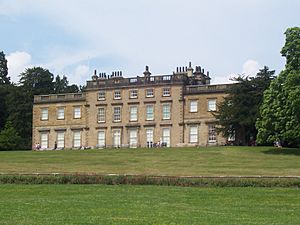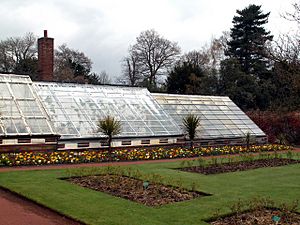Cannon Hall facts for kids
Cannon Hall is a beautiful country house and museum in South Yorkshire, England. It's located between the villages of Cawthorne and High Hoyland, about 5 miles (8 km) west of Barnsley.
This historic house was once the home of the Spencer family and later the Spencer-Stanhope family. Today, it's a museum filled with amazing collections. You can see fine furniture, paintings, ceramics, and glassware. Cannon Hall also hosts a special "Family of Artists" exhibition from the De Morgan Foundation. This exhibit shows the connections between the Spencer Stanhopes and the De Morgans.
The building itself is made from sandstone. It has a balanced design with a tall, central part and two slightly smaller wings on the sides.
Contents
The Story of Cannon Hall
Early Days and a Tricky Time
Cannon Hall has a long history, going back to at least 1086. It got its name from Gilbert Canun, who lived there in the 1200s. By the late 1300s, the Bosville family owned the Hall.
During this time, a difficult event happened at Cannon Hall. The Bosvilles had rented the Hall to a family. Their daughter was connected to a man named Lockwood. This man was involved in a serious incident with a local official. The family living at Cannon Hall became worried. They sent a message to the Bosville family. Bosville's men arrived, and the situation was resolved.
The Spencer Family Arrives
After this, Cannon Hall's history became much calmer. In 1660, John Spencer bought the estate. His family came from Wales. The Spencers were very active in the local iron and coal industries. John Spencer (who passed away in 1729) helped his family build a large business. This success allowed them to rebuild and improve Cannon Hall.
Building the Grand Hall
The main part of the Cannon Hall you see today was built in the early 1700s. It was likely designed by John Etty of York. The beautiful wooden details inside were probably made by William Thornton. Later, between 1764 and 1767, the famous architect John Carr added wings to the building. These wings were later made taller, giving the Hall its current grand look.
The last family member, Elizabeth, sold the house to Barnsley Council in 1951. Cannon Hall Museum officially opened its doors to the public in 1957.
What's Happening at Cannon Hall Today?
Cannon Hall Museum, its park, and gardens are managed by Barnsley Metropolitan Borough Council. The Hall always has fun things going on! They host events like the yearly Regency Ball and a Christmas Fair every December. You can also join guided tours, workshops, and special activities for children throughout the year. There's even a shop in the old potting shed where you can buy plants and gifts.
Beautiful Gardens and Special Plants
The large park around the Hall was designed in the 1700s by Richard Woods. It has many acres of open land, lovely lakes, waterfalls, and interesting structures called follies. Near the Georgian walled garden, you'll find the Victorian pleasure grounds. The walled garden itself is home to a special collection of over forty different types of pear trees!
The main glasshouses were rebuilt in the Victorian era. They house a very special plant: the original Cannon Hall Muscat grapevine. People say this large white grape came from a seed brought back from Greece by John Spencer Stanhope. This grape has been grown widely in places like California and Western Australia. It has also been used to create new types of grapes, including the Japanese Pione grape.
The De Morgan Foundation Exhibition
Since March 2016, Cannon Hall Museum has worked with the De Morgan Foundation. This charity helps protect the artworks of William De Morgan and Evelyn De Morgan. Because of this partnership, the "Family of Artists" exhibition opened in the east wing of the Museum. It's a long-term display that you can still enjoy today.
See also
- Grade II* listed buildings in South Yorkshire
- Listed buildings in Cawthorne
- Cannon Hall Farm



